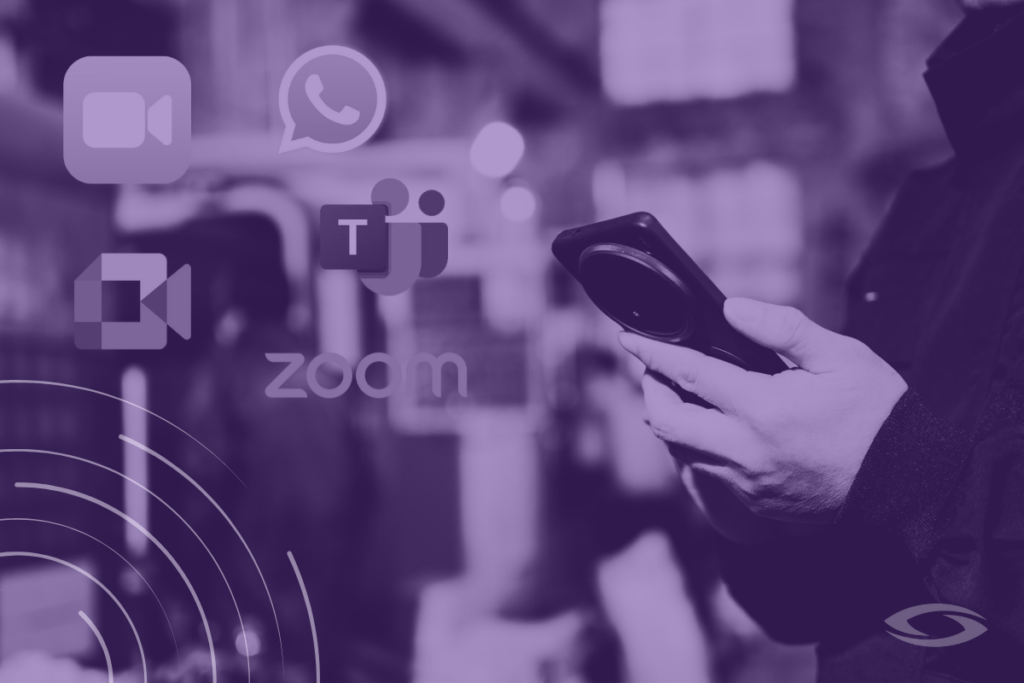Many service organizations turned to video communication during the pandemic — and for good reason. Video helps bridge distance, accelerate troubleshooting, and reduce costly truck rolls.
But while apps like FaceTime, Zoom, Microsoft Teams, and WhatsApp offer a quick fix, they aren’t built for the rigors of enterprise field service.
It’s time to recognize the difference between “over-the-counter” video chat software and purpose-built visual assistance solutions like SightCall — and the competitive edge they can deliver.

Why Consumer Video Tools Are Costing You Time, Money, and Trust
Let’s get honest: tools like FaceTime and Teams are convenient — but they weren’t designed for field environments, high-stakes diagnostics, or enterprise-grade workflows.
Here’s where they fall apart in the moment of service:
No Integration with Service Workflows
Consumer video apps weren’t built for field service. They operate outside your enterprise systems, making it impossible to link calls to service cases, capture critical moments, or extract structured data. The result? Operational blind spots and more manual work for your teams.
Example: A field engineer using WhatsApp to show a malfunctioning pump must then manually upload screenshots and notes into the FSM system — introducing delays, duplication, and errors. It also makes post-call reporting nearly impossible to automate.
Lack of Diagnostic Tools
Consumer video apps offer basic face-to-face interaction—but they fall short when real troubleshooting begins. There’s no way to visually annotate, recognize objects, or remotely point and guide technicians through a fix. Without those tools, true hands-on support isn’t possible.
Consequence: A tech may waste valuable time misidentifying a component or describing it inaccurately, leading to wrong part orders or second truck rolls. Over time, this compounds into lower first-time fix rates and higher service costs.
Security and Compliance Gaps
While Zoom or FaceTime may have encrypted options, they are not built to meet industry-specific regulatory requirements. When working in healthcare, finance, utilities, or aerospace, data security and compliance aren’t negotiable — they’re mission-critical.
Risk: A single FaceTime call between a support agent and a medical equipment technician could expose confidential patient data — a compliance nightmare. Without audit trails or proper access controls, consumer apps simply don’t meet enterprise standards.
Inconsistent Performance in the Field
Technicians often operate in remote, high-interference, or bandwidth-constrained environments. Consumer apps were built for Wi-Fi and suburban convenience, not for service bays, offshore rigs, or underground utility tunnels.
Impact: A remote support call that drops mid-diagnosis or fails to load in a remote location costs time, money, and customer confidence. If your team can’t rely on the tool, they won’t use it — and you’re back to expensive dispatches.

How SightCall Solves the Problems That Consumer Apps Can’t
SightCall isn’t just another video app. It’s a remote visual support solution designed from the ground up for enterprise field service. Here’s what sets it apart — and why that matters to you:
Seamless Integration with Enterprise Systems
SightCall integrates seamlessly with the platforms your service team already relies on—like Salesforce, ServiceNow, and SAP. Every call is automatically tied to the right customer record, with media files, diagnostics, and technician notes saved exactly where they belong.
Advantage: This eliminates redundant data entry, reduces errors, and empowers your support and field teams with contextual insights before and after the call. It also strengthens knowledge-sharing and team collaboration across the business.
AI and AR-Powered Guidance
With tools like AR overlays, remote flashlight control, barcode scanning, and AI-powered prompts, SightCall transforms a simple video call into a hands-on, expert-guided repair session. It’s like having a senior technician right there, guiding every step—no matter the distance.
Competitive Edge: This shrinks the skills gap, accelerates training, and ensures consistent quality across the service team. Your best experts can now support more jobs in less time — without ever leaving the office.
Built-In Security and Compliance
SightCall is designed with enterprise-grade security baked in, not bolted on. It includes end-to-end encryption, secure media storage, role-based permissions, and detailed audit trails — all aligned with major compliance frameworks like HIPAA, GDPR, ISO 27001, and SOC 2.
Peace of Mind: You don’t have to second-guess whether a call is secure or if data will be mishandled. You gain the confidence to scale remote service safely in regulated environments.
Built for the Field
SightCall is optimized for the real-world conditions your techs face — low bandwidth, unstable connections, and remote geographies. It can adapt video quality on the fly, capture evidence even offline, and re-sync once the network returns.
Resilience: When the stakes are high and the connection is poor, SightCall keeps the support going. This ensures that even the most remote sites are never truly unsupported.

Create a Competitive Advantage
Your competitors are dealing with the same macro pressures: a retiring workforce, rising customer expectations, and operational budget scrutiny. What sets top-performing service organizations apart is how they enable their teams.
A remote visual support solution helps you:
- Boost First-Time Fix Rates by empowering techs with instant expert support and visual guidance.
- Accelerate Ramp-Up for New Hires with structured workflows and real-time mentorship.
- Enhance CX and Loyalty by solving problems faster and reducing frustration for customers.
- Turn Service Data Into Strategy by capturing every session as a structured, searchable resource.
Relying on consumer video tools for enterprise field service is inefficient, unsustainable and ultimately, irresponsible. You risk costly delays for customers, data loss, and missed opportunities for growth. These tools weren’t designed for complex diagnostics, secure data handling, or seamless system integration.
If you’re still using Zoom or FaceTime in the field, now’s the time to act. The longer you wait, the further you fall behind.



